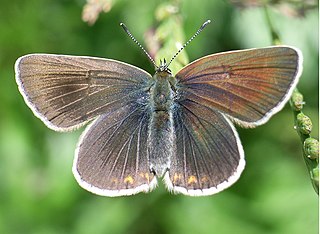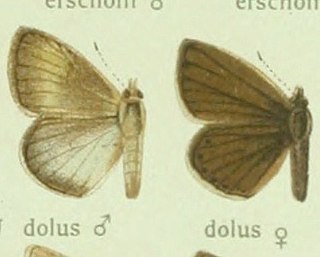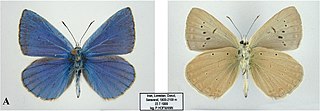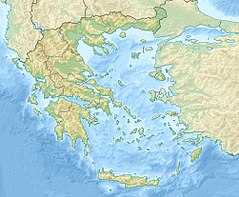
The chalkhill blue is a butterfly in the family Lycaenidae. It is a small butterfly that can be found throughout the Palearctic realm, where it occurs primarily in grasslands rich in chalk. Males have a pale blue colour, while females are dark brown. Both have chequered fringes around their wings.

Polyommatus is a diverse genus of butterflies in the family Lycaenidae. Its species are found in the Palearctic realm.

Polyommatus eros, the Eros blue or common meadow blue, is a species of blue butterfly found in the Palearctic.

The Piedmont anomalous blue is a species of butterfly in the family Lycaenidae. It is endemic to Italy, where it is known from the Aosta Valley in the Italian Alps. It is mainly found on altitudes of 800 to 1,000 meters but at times up to 1,600 meters.

Eumedonia eumedon, the geranium argus, is a butterfly of the family Lycaenidae. It is found in the Palearctic realm. This butterfly has been included in the genera Plebejus, Plebeius, Polyommatus and Aricia, but recent molecular studies have demonstrated that Eumedonia is a valid genus, different from the previous genera mentioned.

Polyommatus damon, the Damon blue, is a butterfly of the family Lycaenidae.

Polyommatus daphnis, the Meleager's blue, is a butterfly of the family Lycaenidae.

Polyommatus escheri, Escher's blue, is a butterfly of the family Lycaenidae. It is found in Southern Europe and Morocco.

Polyommatus dolus, the furry blue, is a butterfly of the family Lycaenidae. It is found in Spain, in France and Italy.

Ripart's anomalous blue is a butterfly in the family Lycaenidae.

Polyommatus admetus, the anomalous blue, is a butterfly of the family Lycaenidae. It was described by Eugenius Johann Christoph Esper in 1783. It is found in south-eastern Europe and Turkey.

Polyommatus aroaniensis, the Grecian anomalous blue, is a butterfly in the family Lycaenidae. It was described by John W. Brown in 1976. It is found on the Balkan Peninsula.

Polyommatus atlantica, the Atlas blue, is a butterfly in the family Lycaenidae. It was described by Henry John Elwes in 1905. It is found in North Africa.

Polyommatus (Agrodiaetus) violetae, the Andalusian anomalous blue, is a species of butterfly in the family Lycaenidae. It is found in the south and south-east of Spain. Adults are on wing from July to August.

Polyommatus golgus, the Sierra Nevada blue, is a species of butterfly in the family Lycaenidae. It is endemic to Spain with habitat in the Sierra Nevada in Andalusia, and is an endangered species.
Turanana taygetica is a butterfly of the family Lycaenidae. It was described by Rebel in 1902. It is found in Greece and Turkey.

Polyommatus karindus is a butterfly of the family Lycaenidae. It was described by Norman Denbigh Riley in 1921. It is only known from the Iranian Zagros Mountains. The habitat consists of dry slopes, gorges and plateaus with xerophyte or steppe vegetation, sometimes wooded areas from 1,800 up to 2,800 meters.
Polyommatus australorossicus, the South-Russian blue, is a butterfly species in the family Lycaenidae. It was described by Vladimir A. Lukhtanov and Alexander V. Dantchenko in 2017 and is found in southern Russia in the Caucasus Mountains.

Ali Botush, also spelled Alibotoush, is a nature reserve in the small mountain range of Slavyanka, located on the border between Bulgaria and Greece. The reserve occupies the northern section of the mountain which lies within the territory of Bulgaria and takes its name from the old name of Slavyanka. It is situated in the municipalities of Sandanski and Hadzhidimovo, Blagoevgrad Province. It was declared in 1951 to protect the largest forests of the endemic Bosnian pine in the Balkan Peninsula. Its territory was further expanded several times and spans an area of 1638 ha or 16,38 km2. It was declared a UNESCO Biosphere Reserve in 1977.
This page is based on this
Wikipedia article Text is available under the
CC BY-SA 4.0 license; additional terms may apply.
Images, videos and audio are available under their respective licenses.

















